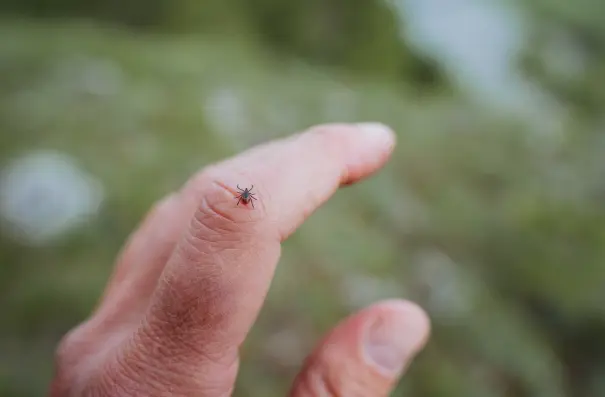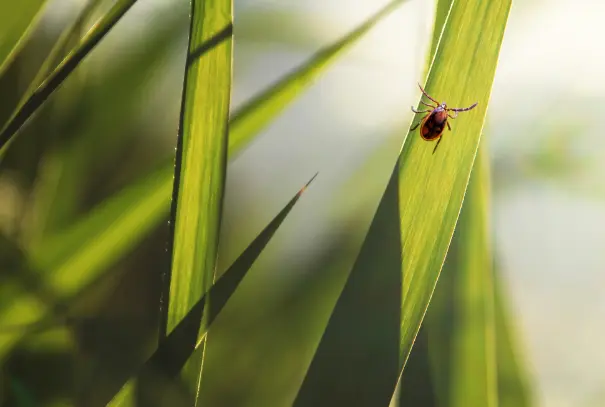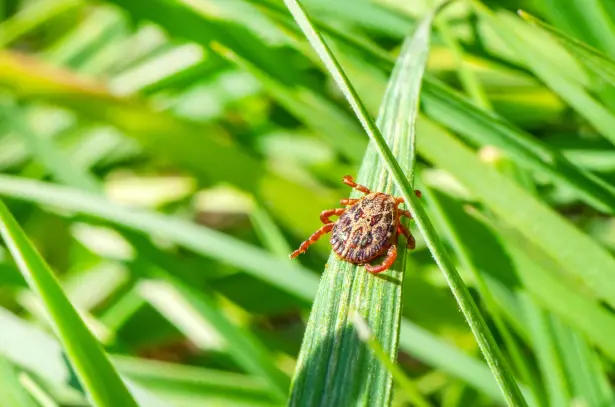
Mosquito Joe offers effective strategies to prevent ticks in your yard:
|
Every homeowner dreams of a yard where they can relax, kids can play, and pets can roam freely. However, this dream can quickly become a nightmare with dangerous ticks lurking unseen around your property. These tiny pests can have a massive impact on the health of humans and pets. But with effective tick pest control and our guide to tick prevention for the yard, you can reclaim your outdoor haven, relax, and enjoy the outdoors again. Here are seven useful tips that will help keep ticks away from your backyard.
First, Understanding Different Kinds of Ticks in the Yard
Out of approximately 850 species of ticks worldwide, over 90 can be found in the United States. However, not all of these are dangerous ticks. Most tick species don’t bite humans, though most do feed on our pets and other animals. The ticks that are most likely to bite people and transmit disease are:
- American dog tick, also called a wood tick — can spread Rocky Mountain spotted fever, Tularemia, and tick paralysis.
- Blacklegged tick, also called a deer tick — can transmit Lyme disease (or its agent, Borrelia burgdorferi), Bartonella, relapsing fever Borreliosis, deer tick virus, and Powassan virus.
- Brown dog tick — can spread Rocky Mountain spotted fever and Q fever.
- Gulf Coast tick — can spread a spotted fever similar to Rocky Mountain spotted fever.
- Lone star tick — can transmit Rocky Mountain spotted fever, Tularemia, Bourbon virus, Heartland virus, Q fever, and tick paralysis.
- Rocky Mountain wood tick — is the primary vector for the Colorado tick fever virus (CTFV) and Rocky Mountain spotted fever.
- Western black-legged tick — can transmit Lyme disease, human granulocytic anaplasmosis (HGA), ehrlichiosis, and babesiosis.
The tick-borne pathogens listed here are just those harmful to humans. Ticks can also cause our pets to get sick or even die. It’s a good practice to assume any tick you or your pet encounters is a dangerous tick.
Fortunately, our tick prevention techniques are equally effective for all tick species.
Why Is It Important to Efficiently Control Ticks?
It’s true that most ticks don’t bite humans, and those that do don’t always transmit disease. However, don’t skip learning about tick prevention because you like your odds! Even when it’s not a “dangerous tick” that bites, every tick bite sucks the blood from its warm-blooded host, whether wildlife, pets, or people. While doing so, they cut a hole in the skin to insert a barbed feeding tube.
If not removed, a tick will remain attached to its host, feeding on blood for seven to ten days. Unless the tick is removed properly, tugging stimulates the tick to salivate and regurgitate into the host’s bloodstream. Meanwhile, improper removal may cause the tick’s head and jaws to pop off the body and remain embedded in the host. That is exactly as disgusting and unsanitary as it sounds.
Even when they don’t transmit diseases like Lyme disease and Rocky Mountain spotted fever, tick bites can get infected and cause anemia in humans and pets.
So, let’s review how to prevent potentially dangerous ticks from inhabiting your yard.
7 Tips for Preventing Ticks in the Backyard

The following tips for preventing ticks in the yard will help protect you, your family, and your pets from these nasty biters.
1. Landscaping Strategies to Deter Ticks: Landscaping isn't just about aesthetics; it's also about keeping dangerous ticks and other pests out of your yard. Implementing strategic tick prevention through landscaping can drastically limit the tick population in your yard. Start by trimming tall grasses, bushes, and any overhanging branches, thus removing the preferred habitats of these pests. Move swing sets and sandboxes away from wooded areas. Keep fences and other barriers to wildlife in good repair. A tick can ride in on an animal, drop off, and be ready to bite you or your pet.
Don't stop there! Construct natural barriers using 3-foot-wide gravel or wood chip borders between your lawn or garden and any adjacent wooded areas, as well as around playgrounds and patios. This forms a physical barrier that is often too dry or warm for ticks to endure. Additionally, these borders act as a visual cue, reminding family members to take tick prevention precautions when they enter the wooded areas.
2. Regular Lawn Maintenance: Ticks love long grass stems and overgrown shrubs. They climb to the leaf tips, reaching out, “questing” for an unwary host to walk past so they can grab hold. When you regularly mow and maintain a low grass height (about 2.5 inches), you deny ticks their favorite habitat, making it harder for them to use your yard as a hunting ground. Keeping the weeds pulled, shrubs and lawn maintained, and leaf litter picked up leaves the biters no place to hide. Regular lawn maintenance is essential tick prevention for the yard.
3. Consider Eco-Friendly Tick Repellents: Harness the innate power of plants as your frontline defense in tick prevention. Certain plants, like the fragrant lavender, rosemary, and chrysanthemums, are nature's own tick repellents. These species emit strong scents that naturally help deter ticks. Integrating these plants into your yard's landscape builds a naturally fortified barrier against dangerous ticks while creating an inviting garden for your family and pets.
4. Install Physical Barriers: Keeping deer and other tick-bearing wildlife off your property is one of the most effective means of tick prevention for your yard. An effective deer fence can result in a 90% drop in the tick population in your yard over time. But the fence must not be scalable by wildlife or have holes large enough for smaller animals and rodents to crawl through. Adding a 3-foot-wide gravel barrier to the base of the fence will provide even better tick prevention for your yard. Any ticks that drop off into the gravel will struggle to survive.
5. Don’t Overwater: Don’t overwater your lawn, shrubs, and garden plants. Ticks are attracted to moisture and rely on it to survive between hosts. Keep water features and bird baths that can attract tick-bearing wildlife well away from pet areas. For the same reason, keep bird feeders and squirrel feeders cleaned up and away from pets and livestock.
6. Regularly Treat Pets and Livestock: After wildlife, your pets and livestock are the most likely local hosts to be attacked by ticks. They are prime targets for dangerous ticks. To protect them, trust in tick prevention products recommended by veterinarians. You’ll find topicals that are applied monthly and spot-treatment sprays that are also effective. Make it a practice to examine your pets closely for ticks after every outdoor venture. If you find an embedded tick, take immediate action. Removing a tick from a dog can be done effectively at home with simple tools and the right approach.
7. Professional Yard Treatments: Ticks can be stubborn pests. Sometimes, even the best DIY approaches fall short. That's when professional tick prevention for the yard steps in to save the day. Experts equipped with knowledge and the right tools can deliver targeted treatments that zero in on the areas in your yard that are the most susceptible to ticks. This approach helps curb the tick presence but also ensures a limited use of chemicals.
Are you facing persistent tick issues? Don't wait. Contact your local Mosquito Joe® for comprehensive tick prevention and tick control services you can trust.
Additional Steps to Preventing Ticks from Biting
Most Americans who get bitten by ticks pick them up in their own yard or garden. That’s why it is so important to learn how to prevent ticks in the yard. However, ticks are also commonly found at most of our favorite outdoor destinations, including the mountains, the woods, and beaches. Let’s consider additional tick prevention steps to prevent these nasty biters from ruining your outdoor fun.
Know When to Apply Tick Spray:
A tick-repellant spray with a concentration of 20-30% DEET is effective tick prevention. Several sprays on the market are effective at preventing tick bites on hiking and camping trips for people and dogs. When it’s the height of tick season in your area, a repellant spray is an excellent way to protect you, your family, and pets from dangerous ticks while on vacation.
Know Which Areas to Avoid:
Do some basic Google research to learn whether you live, work, or vacation in an area with a high tick population. This knowledge can help you prioritize your tick prevention efforts. The CDC geographic tick distribution site is a valuable resource for mapping dangerous tick populations.
Dress Accordingly:
If you go hiking or camping in an area where ticks are a problem, wear light-colored clothing so tiny ticks are easier to spot on you. Also, choose clothing that covers your skin, including long sleeves, a high neck, long pants with the legs tucked into your socks, full-coverage shoes, and a hat. Using a DEET tick repellant spray and then dressing carefully is the best approach to preventing tick bites while hiking and camping.
Remain Vigilant for Ticks and Bites:
Preventing ticks in the yard is the first vital step to avoiding an infestation in your home. Take care to inspect yourself, your kids, and your pets when coming in from exposure to ticks. Shower or bathe to easily dislodge any ticks that have not attached. Then, carefully search for ticks, with particular attention given to the following areas:
- Neck
- Under arms
- Behind ears
- Behind knees
- Inside elbow joints
- Under hair and on the scalp
- Inside the belly button
- Around the waist
- Groin area
When examining pets for dangerous ticks, run your hands along their skin, feeling for bumps. Check the spots listed above and around your pet’s mouth, ears, under the tail, and between their toes.
Have Routine Tick Control Treatment by a Trusted Professional
A professional tick control service makes preventing ticks in your backyard and garden much easier and more effective. Together with our tick prevention tips above about denying them a suitable habitat in your yard, professional tick pest control will help to keep them from taking over your property.
Contact Mosquito Joe Today or Tick Control in Your Yard
While ticks can pose a problem and threat for any humans and pets who venture outdoors, there are proven methods that can help limit your exposure. Mosquito Joe been providing reliable tick prevention and control since 2010. We also provide effective mosquito and flea control services.
When you hire Mosquito Joe, our local team members arrive promptly, in uniform, driving a marked van loaded with the equipment and expertise needed to do the job right the first time. Plus, all our work is backed by the Neighborly Done Right Promise® and the Mosquito Joe Satisfaction Guarantee!
At Mosquito Joe, tick prevention for your yard and family is our business. Contact us for a free quote or to schedule professional pest control services.


